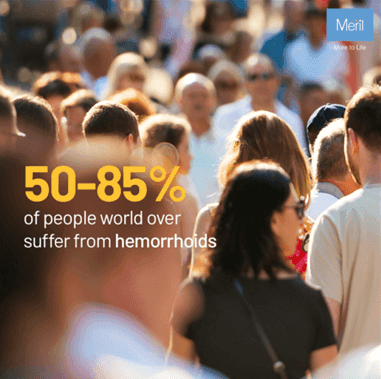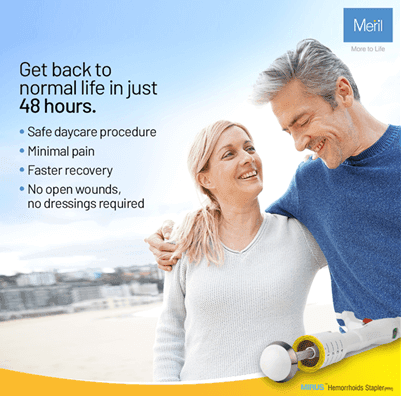Piles - Treatment & Surgical Procedure
What are Piles?
Haemorrhoids are swellings that develop from the lining of the anus and lower rectum (Anal canal). There is a network of small veins (blood vessels) within the inside lining of the anus and lower rectum. These veins sometimes become wider and fill up with more blood than usual. The veins and the overlying tissue may then form into one or more small swellings called haemorrhoids. Sometimes they may be felt outside anus. This stage is called prolapsed hemorrhoids. Hemorrhoids are classified as internal and external haemorrhoids. A person suffering from piles or hemorrhoids will present with bleeding while passing hard stools, this bleeding is depending on the grade of hemorrhoids .

How common is incidence of piles?
Incidence of piles is common in both men and women. Those with improper dietary habits and sedentary lifestyle have a greater incidence of piles. According to a recent health estimate, over 40% of the world population suffers from piles and as many as 40% of the population have experienced symptoms of this disease sometime in their life. In India, approximately 80% of the patients belong to the age group of 21 – 50 years. Piles are also seen among pregnant women.
What are the causes of piles?
The great main causation here is that the vein or bunch of veins which is forming the hemorrhoidal mass sometime has a blood clot within it and that gets pushed outwards causing severe pain to the patient, such conditions require emergency treatment to reduce the pain and can be done on, out patient basis
Piles can be caused due to
- More pressure on blood vessels near the rectum results in Piles
- More pressure in and around the anus causes Hemorrhoids.
- If you are eating too much spicy food leads to piles as the heat generated by the spicy food is very high. While passing the stool it results in inflammation and swelling in blood vessels near the rectum
- If you are Eating hard food daily results in piles too. The harder the food harder the stool. As the hardness of the stool increases the pain while passing the stool increases which also puts pressure on the blood vessels in the rectum and anal canal that results in their inflammation and swelling which can result in piles
- If you are have Less consumption of water it makes your stool harder. As the hardness of the stool increases, it becomes more painful while passing it which results in inflammation and swelling.
- Also Sitting at the same place for a long period will also result in piles.
- Weightlifter- Carrying heavyweights will put pressure on your whole body. Usually, we hold breath while lifting weights, this will makes the air pass downwards from the lungs which puts pressure on your internal organs and veins in the rectum.
- The pressure on the veins and blood vessels near the anus and colon increases in the individuals who are obese due to overweight.
What are the symptoms of piles?
Symptoms range from temporary and mild, to persistent and painful. In many cases, hemorrhoids or Piles are small and symptoms settle down without treatment. If required, treatment is usually effective. There are various treatment options. The exact reason why these changes occur and lead to hemorrhoids or Piles forming is not clear. Some hemorrhoids seem to develop for no apparent reason. However, it is thought that the pressure in and around the anus can, in many cases, be a major factor. If the pressure in and around the anus is increased, then it is thought that this can lead to hemorrhoids developing
- In different stages of development, the symptoms vary, gradually becoming worse.
- The main symptoms of piles are swelling and itching in or around the rectum.
- In late stage, pain and itching are also with bleeding while passing the stools.
- Patient might feel an uncomfortable mass inside the anal canal.
- If the piles are prolapsed, patient may feel them while washing after the use of the toilet.
Internal hemorrhoids
Internal hemorrhoids these form in the Anal canal about 2 to 4 cm above the rim (opening) of the anus. Their severity and size are classified into grades 1 to 4. Internal (inside) hemorrhoids or Piles are found in the anus under the lining for the rectum. It can cause severe pain if it is completely "prolapsed". This means that it is coming out the anal opening and can’t be pushed back inside.
4 grade of hemorrhoids are
- First grade where in the hemorrhoidal mass or the bunch of veins which are enlarged are still within the anal canal and not visible outside. small swellings on the inside lining of the Anal canal.. Grade 1 hemorrhoids are common. In some people they enlarge further to grade 2 or more.
- Grade two is when they come out while passing the hard stools may bleed and then go back in once the person passes the stools. They are larger as compare to grade 1. It may be partly pushed out (prolapsed) from the anus when you go to the toilet and spontaneously disappear back inside again.
- Grade three (hang out (prolapsed) from the anus.) is once the hemorrhoid mass comes out the person has to actively push back the mass into the anal canal to prevent it from causing any further problems. You may feel one or more as small, soft lumps that hang from the anus. However, you can push them back inside the anus with a finger.
- Grade four is when the mass comes out and is not going in even after act of or manually trying push the whole mass inside.
External (outside) hemorrhoids
External (outside) hemorrhoids are found near the anus. Sometimes a blood clot (thrombosis) can happen with outer hemorrhoids. Patients may feel skin tags that develop from stretching of peri anal skin.
Prolapsed haemorrhoids –
a more severe and painful form of internal haemorrhoids. These veins push through the anus and hang out of the body, particularly after going to the toilet. Sometimes, the anal sphincter (ring of muscle) can strangulate veins that hang out permanently
How to diagnose Piles (Hemorrhoids)
Patient with rectal inflammation, swelling, pain, discharge, and bleeding at the time of defecation, it is advisable not to believe that it is the outcome of hemorrhoids, detailed evaluation is required, including rectal examination, proctoscopic examination, and in some cases sigmoidoscopy or colonoscopy.
The doctor will check the anus and rectum for swollen blood vessels that suggest hemorrhoids and will also do a gloved near rectal test.
Lubricated finger to feel abnormal, with a hollow lighted tube anoscope helpful for viewing internal hemorrhoids.
Pain is absent until complications occur, which is why any patient complaining of 'painful hemorrhoids' must be accused of possessing another disease and must be examined appropriately.
Several other disorders such as rectal or anal carcinoma, bowel cancer, and other stomach issues cause the same effects as hemorrhoids, so it is best to see a doctor if a patient has any rectal bleeding.
What are the complications in piles?
The common complications associated with the problem include blood loss, loss of nutrients and important vitamins. In case of piles is strangulated, one can suffer from the problem of blood loss. If piles go untreated for a long duration, the problems may include:
Infection
Anal fistula
Gangrene
Incontinence in rare cases
Anemia due to excessive blood loss
In case of an infection paired with concomitant diseases such as blood pressure, heart diseases, and diabetes, the condition can get worse and tough to control. It may pose a risk one of the lives of the patient. In case one has piles, it is important to connect with the doctor and avail treatment at the earliest. Besides treatment, one should also consider to bring moderate changes in the lifestyle and prevent the piles from worsening in the first place.
What can be done to prevent piles?
- Increase the fiber intake through your food vegetables and fruits, fresh food, whole grains and cereals.
- Avoid oily and fast food
- Establish regular bowel habits and avoid constipation
- Avoid spicy food, alcohol, coffee and tea
- Exercise regularly to keep weight in check
- Avoid prolonged sitting or standing positions
- Drink at least 8-10 glasses of water every day. This will soften the stools and will help move the waste through the intestine smoothly.
What are the Option available for Piles Treatment
- It is very important to have a correct diagnosis first. So ask the patient to visit a doctor for proper diagnosis.
- If detected early, piles can be cured with medication and life style changes.
- In the later stages, surgery is a must and there are various surgical procedures available to treat piles problems.
- Mainly surgical options are classified as conventional and Minimally Invasive Procedure for Hemorrhoids (MIPH).
A groundbreaking three-row approach to Minimally Invasive Treatment for Prolapsed Hemorrhoids MIRUS HEMORRHOIDS STAPLER. It is also available in the standard two-row model. MIRUS HEMORRHOIDS STAPLER offers improved protection, superior homeostasis and ease of use, allowing optimal excision of prolapsed hemorrhoid tissue. Optimized staple forming technique provides flexible height staples that cause less tissue stress and delivers proper compression and staple line at maximum closed height.
In Piles when is surgery necessary?
Surgery may be required if there is serious or continuous pain from a thrombosed hemorrhoid (a blood clot within a blood vessel). Harmful or large hemorrhoids often need special or surgical care. The surgical technique used depends on the form, size and position of the hemorrhoid.
- Ligation or hemorrhoid banding.
- Injection and coagulation.
- Hemorrhoid stapling.
- hemorrhoidectomy.
What is the difference between conventional surgery and MIPH?
Since many years, piles' patients have been operated through conventional surgery approach. This approach will generally cost less but has various disadvantages such as pain after operation for 2-3 weeks. He might need hospital stay after operation for more than a week. The surgical wounds need dressing for 2-3 weeks. On an average it takes 4-5 weeks for complete recovery. Patient needs a frequent follow up with the doctor.
- Minimally Invasive Procedure for Hemorrhoids (MIPH)MIPH
- Recently, the technique has come up to treat piles. It is called as Minimally Invasive Procedure for Hemorrhoids (MIPH).
- This advance technique is being increasingly recommended by surgeons around the country. This operation is performed with the help of a stapler device and patient may go home on the same day.
- Patients who have undergone this procedure reported minimum post operative pain.
- No dressings are required and the patient can resume work in 4-5 days time.
- So if the surgeon recommends surgery, discuss MIPH with him/ her.
Hemorrhoidectomy | Piles Treatment
Surgery needs a brief stay in the hospital, usually on a day-to-day basis. You could be in the hospital on the day of the surgery, or even the day before. Before the surgery, the anaesthetist will visit you. You should have nothing to eat for 6 hours before surgery and nothing to drink for 2-3 hours beforehand. Your blood flow, heartbeat and wounds will be carefully watched in the first three hours. You'll usually be able to start drinking immediately after the treatment, and you should start eating as soon as you're hungry. You will usually be able to get out of bed a few hours after surgery, and the nurses will support you for the first time.
Dresses
After treatment, a dressing can be kept in place of elastic trousers. There will be some blood staining in the first 12 hours. When you're wearing a dressing, it'll come off the following day, usually on its own. The wound is going to be a little moist for a week or two.
Pain
There will be some discomfort and some patients will have serious pain for a couple of days. It is normally treated with basic analgesics. About a week later, the wound was nearly pain-free.
Heading back home
Many patients go home the next day, but often overnight stays can be needed. This would depend on how fit you are, who is at home with you, and how happy you are after the surgery. For the first few days, you may feel more exhausted than normal due to anesthetics.
Stitches
Any strings tied around the pile stumps will be lowered by themselves within 4-5 days. This could be followed by a sort of bleeding. Any other stitches are dissolved.
Other signs
There could be some purple bruising around the cut – it's natural and it's going to disappear. Occasionally you can find it complicated. It's controlling the breeze from your back. This is going to get better in a day or two.
Constipation
After the treatment, it is important to prevent being constipated. Unnecessary bleeding and pain can result from straining. To stop constipation, a balanced diet containing fibre, fruit and vegetables and consuming lots of fluids will all help. (When you take in fibre, you must drink enough or you can get constipation.) For the first two days, you will usually be given a laxative to take at home.
It may be uncomfortable the first moment you open your bowels, but this will soon change. We consider a laxative that operates by attempting to produce a stool that is smooth and 'easy-to-pass'. A laxative on discharge can be given to you; otherwise you may buy it at any pharmacy.
Moving Driving
As soon as you are secure enough to comfortably make an emergency stop, you can drive. Generally, this is within 4-5 days.
Gender
As soon as it is comfortable to do so, you can resume sexual intercourse.
Going back to work
Its benefits include:
- Less pain
- Faster recovery
- Faster regaining of normal bowel function
- Less postoperative care after discharge
- Faster return to normal work
Ligation or hemorrhoid banding | Piles Treatment
rubber band ligation we do it using a special heinous cope instrument that shows us and allows us to see the hemorrhoids the rubber bands are very small little rubber bands very similar to the ones that are used by the orthodontist the hemorrhoids on the inside we can grab them use a special rubber band line gaiter grab the hemorrhoid and then apply the rubber band at the base of the hemorrhoid pedicle such as this it'll turn purple blue we're going to do this one two three and it's going to be over simple procedure over very quickly five minutes it's done the recovery period is very minimal usually about three to four hours of swelling filling as if you have something inside the anus area filling it like you have to have a bowel movement and nothing needs to come out it's just really the hemorrhoid being treated with the rubber band once the hemorrhoid falls all that swelling sensation goes away and people do just fine you go one two three third procedure one more week and you're cured
Hemorrhoid stapling or Stapled hemorrhoidopexy | Piles Treatment
Stapled hemorrhoidectomy, also known as stapled hemorrhoidopexy, is a surgical procedure that involves the removal of abnormally enlarged hemorrhoid tissue, followed by the repositioning of the remaining hemorrhoid tissue back to its normal anatomic position. Severe cases of hemorrhoid prolapse will normally require surgery.
A circular, hollow tube is implanted into the anal canal for stapled hemorrhoidectomy. A suture (long thread) is inserted through this channel, actually threaded, circumferentially in the anal canal above the internal hemorrhoids. The ends of the suture are separated from the anus via the empty tube. The stapler (a disposable tool with a round stapler at the end) is put into the first hollow tube and the ends of the suture are drawn. The suture draws the extended hemorrhoidal supporting tissue into the jaws of the stapler. The hemorrhoidal cushions are pushed down to their usual location inside the anal canal. The stapler is shot. When it is fried, the stapler cuts off the circumferential ring of the expanded hemorrhoidal tissue stuck within the stapler and at the same time staples the upper and lower sides of the sliced tissue together.
Newer surgical techniques include stapled transanal rectal resection (STARR) and prolapse and hemorrhoid procedures (PPH). Both STARR and PPH are contraindicated in patients with either enterocele or anismus. PPH is usually recommended for more serious cases of internal hemorrhoidal prolapse (3rd and 4th degrees) where surgery will typically be indicated. It can also be recommended for patients with mild hemorrhoids that have not adapted to conservative therapies. The treatment could be contraindicated if only one cushion is prolapsed or if there are serious cases of fibrotic piles that cannot be physically repositioned.
Conclusion: In adults, hemorrhoid (Piles) is a common discomfort that worsens by prolonging urgent care, which has a direct impact on the economy. Colonoscopy and proctoscopy have the right state of condition, aside from the prevalent signs of bleeding and discomfort. For patients with first and third degree hemorrhoids, non-operative treatment approaches are used; relatively few patients with fourth degree hemorrhoids need surgical call therapy. Although the best popular cure is for any disease prevention, hemorrhoids can also be minimized by improvements in behaviour, eating patterns, and the ingestion of sufficient doses of respective botanicals, which can also interfere to decrease vascular integrity in pathogenesis.
Statutory warning: This information is provided with the objective of creating general awareness of the disease and treatment options considering the best interest of people. Please consult a doctor for the right diagnosis and suitable treatment options as per the situation

